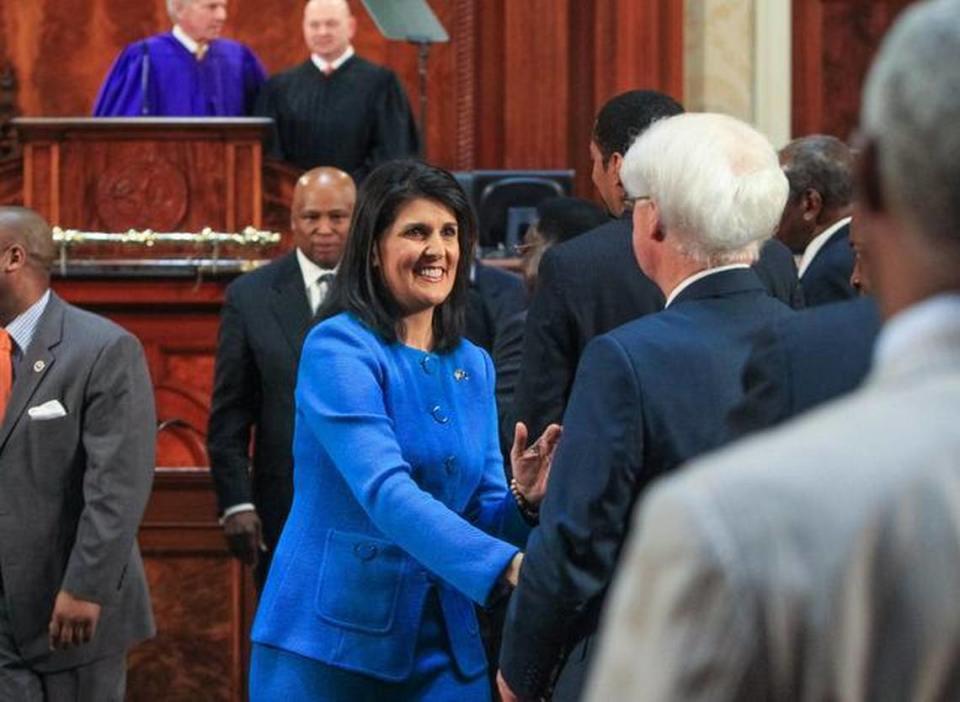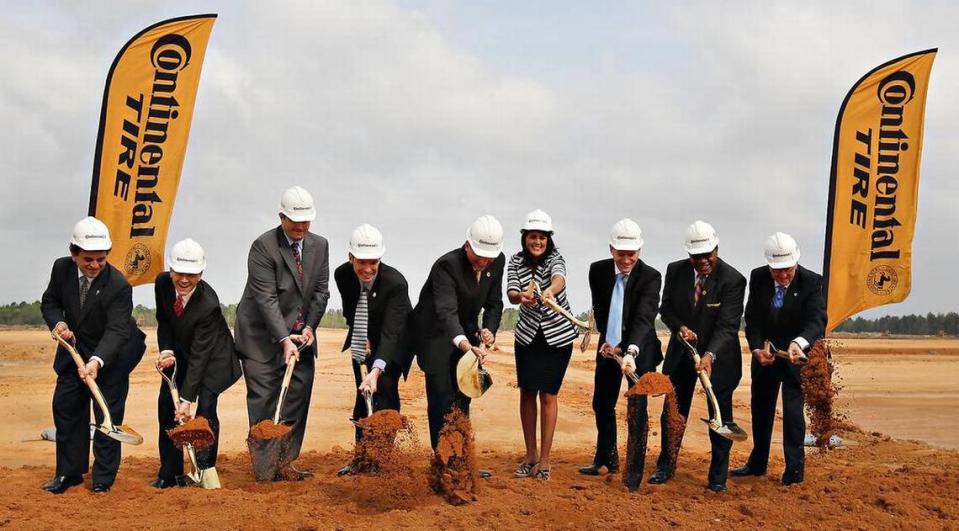Trump attacks Haley on taxes, immigration. What really happened when she was SC governor?
- Oops!Something went wrong.Please try again later.
- Oops!Something went wrong.Please try again later.
Former South Carolina Gov. Nikki Haley has been leaning on her record as governor in the state.
She touts taking on the establishment in Columbia in a State House dominated by men and accomplishing job growth in the state.
As Haley campaigns in her home state, she’s been reminding voters of her record.
The Trump campaign has pushed to make Haley’s perceived strengths a weakness. Even the state’s Democratic Party have poked at Haley’s record in order to keep Democratic voters from participating in the Republican presidential primary and voting for Haley.
Immigration attacks
When it comes to immigration, the Trump campaign points to Haley’s denouncement of Trump’s proposal for a Muslim travel ban, and even claims she supported Syrian refugee resettlement in South Carolina.
Stopping illegal immigration and closing the border has been a central issue for Trump and his campaign.
“Donald Trump knows what the American people want. He’s driving the Trump train of sensible immigration policy,” state Treasurer Curtis Loftis said at a recent news conference. “Nikki Haley and others have recently jumped on that train. But they’re just passengers.”
Trump also has said Haley opposed his plan for a wall along the southern border.
But Haley has said a wall alone wouldn’t work, as the country needed to commit more personnel and other equipment to patrol the border.
Trump’s campaign pointed to her support of the U.S. Refugee Resettlement Program, which helped people who aided U.S. troops overseas.
In 2015, after a Paris bombing, Haley wrote to Secretary of State John Kerry to not resettle any Syrian refugees in South Carolina amid the ongoing conflict in Syria. At the time, none those who came to South Carolina through the resettlement program were from Syria.
But Haley also says she was strong on illegal immigration when she was governor, pointing to a law she signed in 2011 that included the required used of E-Verify to require employers to make sure people working in the state were legally allowed to work in South Carolina. It’s a system she says she wants to see used nationwide.
The Obama administration sued South Carolina over its immigration law, which included provisions to allow law enforcement officers to determine someone’s immigration status if they were pulled over during a traffic stop.
A judgment striking down most of the law included an opinion from Attorney General Alan Wilson’s office saying a local or state law enforcement officer could not detain someone based on their immigration status. Wilson is now backing Trump’s campaign.
“He (Wilson) didn’t defend it as rigorously as other pieces of legislation,” said state Sen. Larry Grooms, R-Berkeley, who authored the state’s illegal immigration law.
Grooms, who is backing Haley’s campaign, said the former governor was instrumental in helping him secure votes to get the bill passed.
“To say she is somehow not strong on illegal immigration is just ludicrous based on what she did here as governor,” Grooms said. “She was tough on it to begin with.”
A debate over a tax record
The Trump campaign, like the suspended campaigns for U.S. Sen. Tim Scott and Florida Gov. Ron DeSantis, says Haley wanted to raise taxes when she was governor. They all point to Haley’s call in 2015 to increase the gas tax to address road infrastructure issues in the state.
However, for years Haley fought against increases to gas tax to help address road conditions in the state. She only supported an increase in the gas tax if it was paired with an income tax cut.
Haley supported a 10-cent increase per gallon of gas from 16.75 cents in the state in exchange for lowering the top income tax rate from 7% to 5%.
That shift would have provided more money to the S.C. Department of Transportation for road work, while also keeping money out of the state’s general fund budget.
She also wanted reform at the S.C. Department of Transportation.
In 2016, South Carolina changed the structure of the transportation department. The governor now appoints members to the S.C. DOT commission with confirmation from lawmakers. It also took the day-to-day decision-making of signing contracts, finalizing permitting and decisions on land acquisition out of the commission’s hands and gave those responsibilities to the department secretary.
A phased-in gas tax increase was passed in 2017 after Haley left the governor’s office to become ambassador to the United Nations.
An income tax cut was passed in 2022, and will ultimately bring the top tax rate to 6% as long as revenues to the state continue to grow.
When Haley was governor however, she did sign a bill that reduced the small business income tax to 3% from 5%.
Trump’s campaign also points to how Haley co-sponsored a bill in 2006 that raised the state sales tax.
The bill, signed by Gov. Mark Sanford, became a law known as Act 388, which was a tax swap. The state increased the sales tax to 6% from 5%, in exchange for cutting property taxes on owner-occupied houses in half.
Haley, who was a state representative at the time, was a co-sponsor on the bill that took two years to get through the Legislature. But so were some other lawmakers who are now high profile, including current House Speaker Murrell Smith, who is backing Trump’s campaign. Then House Speaker Bobby Harrell also co-sponsored the bill, signaling its significance in the Legislature.

Job growth
Haley often says the state added 86,000 jobs during her administration, including each county adding jobs during her six years as governor.
The unemployment rate in South Carolina dropped during Haley’s tenure. According to the Department of Employment and Workforce the statewide unemployment rate in January 2011 was 10.8%. By January 2017 when Haley left to become Trump’s ambassador to the United Nations, unemployment was at 4.4%.
“We all pulled together and we rallied,” Haley says during her stump speech. “From there we went and we started making sure that all those jobs that went overseas with the textiles, we went and said, ‘Let’s start building things in America again, and we’re going to do it in South Carolina.’ By the time I left, we were building planes with Boeing, we were building more BMWs in any place in the world, we brought in Mercedes Benz (and) we brought in five international tire companies.”
South Carolina had many tire plants before she became governor, but five tire manufacturing locations were constructed when she was governor, according to Modern Tire Dealer, an industry trade magazine.
In the year prior to Haley becoming governor, the state’s unemployment rate was 12% in January 2010 and dropped to 10.9% in December 2010 as the country came out of the Great Recession.
Unemployment continued to drop in South Carolina after Haley’s administration and was 3% in December according to the Department of Employment Workforce.
Trump backer, state Rep. Bill Taylor, R-Aiken doesn’t want to give Haley too much credit.
“Every governor has job growth here. This is South Carolina. Everybody wants to be here. So we’ve all had job growth,” Taylor said. ”That’s such an easy claim to make.”

Haley and Medicaid
Haley refused to expand Medicaid as allowed under the Affordable Care Act, commonly referred to as Obamacare.
“There is enough money in our public and private health care system today to make the system work,” Haley said in her 2016 state of the state address. “We can’t spend our way out of this problem – that’s too easy in the short term and too painful in the long term.”
When she was governor she advocated better outcomes for patients.
“We need to improve health care value,” Haley said in the speech. “We are asking Medicaid beneficiaries to be more engaged in their health. If a patient doesn’t follow a doctor’s advice to stop smoking or doesn’t take their medication as prescribed we end up spending more money than necessary, and more importantly, they’ll never get healthy. We have to improve patient engagement – and stop rewarding bad behavior.
But the decision not to expand Medicaid irks Democrats in the state as South Carolina still hasn’t expanded the program even when additional incentives were put in place by the Biden administration.
In 2020, 188,000 would have been eligible for Medicaid if the state expanded the system, according to KFF, formerly known as Kaiser Health News.
“It’s reminding voters who Nikki Haley is and she is the mother of MAGA. It’s reminding voters what Nikki Haley has done in South Carolina and what she was the governor, how she refused to expand Medicaid and forced the only hospital in her hometown (of Bamberg) to close, where her parents lived,” said S.C. Democratic Chairwoman Christale Spain.
Three rural hospitals in the state closed while Haley was governor. Bamberg County Hospital in 2012, Marlboro Park Hospital in 2015 and Barnwell County Hospital in 2016.
The South Carolina Hospital Association acknowledged Haley didn’t expand Medicaid, but said she increased money to support the state’s rural and critical access hospitals.
“The issues that led to the closure of Bamberg Hospital in 2012 preceded the passage of the Affordable Care Act in 2010, and South Carolina’s rural hospitals continue to struggle with those challenges every day,” the hospital association said in a statement. “Population migration to urban centers, fewer commercially insured patients, declines in surgical volume, costly electronic medical records systems and a litany of other factors have made it very difficult to operate an acute care hospital in a rural setting.”

